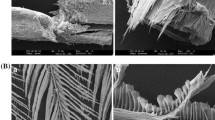Abstract
Comparison of results obtained by growingKeratinomyces ajelloi on wool sterilised by three different methods shows that passing through an autoclave denatures keratin. On the contrary, the use of ethanol after degreasing with petroleum ether maintains the wool in its native state. In addition to variations in rates attack of, variations of proteolytic activity — qualitative as well as quantitative — have been noted when the fungus develops either on autoclaved keratin or by keratin treated on by organic solvent.
Sterilisation in heat enhances synthesis of proteases byK. ajelloi and allows their freeing in the filtrate. Furthermore, the absence of the second protease synthetised by the fungus growing in the presence of native wool, may indicate that the way by which autoclave sterilised keratin is attacked, is different from that of non-denatured keratin.
Résumé
La comparaison des résultats obtenus en cultivant leKeratinomyces ajelloi sur de la laine stérilisée par trois procédés différents montre que le passage à l'autoclave dénature la kératine. Par contre, l'emploi de l'éthanol après dégraissage à l'éther de pétrole permet de maintenir la laine dans son état ‘natif’. Outre les vitesses d'attaque différentes, on note en effet des variations aussi bien qualitatives que quantitatives de l'activité protéolytique lorsque le champignon se développe soit sur de la kératine aseptisée à l'autoclave, soit sur le même substrat seulement traité par les solvants organiques. La stérilisation à la chaleur favorise la synthèse des protéases par leK. ajelloi et permet leur libération dans le filtrat. De plus, l'absence de la deuxième protéase synthétisée par le champignon se développant en présence de laine ‘native’, pourrait indiquer que le mode d'attaque de la kératine stérilisée à l'autoclave, diffère de celui de la kératine non dénaturée.
Zusammenfassung
Vergleich der Ergebnisse, die durch die Züchtung vonKeratinomyces ajelloi an der durch drei verschiedene Methoden sterilisierten Wolle gewonnen worden sind, zeigte, daß die Autoklav-Sterilisierung das Keratin denaturiert. Hingegen verbleibt die Wolle in ihrem Naturzustand durch Behandlung mit Ethanol nach Entfettung mit Petrolether. Neben dem Wechsel der Angriffsrate wurde eine Veränderung der qualitativen und quantitativen proteolytischen Aktivität beobachtet, wenn der Pilz entweder an Autoklav-sterilisiertem Keratin oder an einem mit organischem Solvent behandelten wuchs. Hitze-Sterilisierung vergrößert die Proteasesynthese durchK. ajelloi auch im Filtrat. Die Abwesenheit der zweiten Protease, die durch den Pilz an nativer Wolle synthetisiert wird, zeigt, daß der Weg, durch welchen autoklav- sterilisiertes Keratin angegriffen wird, von dem des nicht-denaturierten Keratin verschieden ist.
Similar content being viewed by others
Bibliographie
Chesters, C. G. C. &Mathison, G. E. (1963) The decomposition of wool keratin byKeratinomyces ajelloi.Sabouraudia. 2:225–237.
Crewther, W. G. (1955) Pretreatments which affect the susceptibility of wool to proteolysis I. The effects of pH, wetting agents and solvent extraction.Proc. Int. Wool. Text. Res. Conf. Aust. C:227–256.
English, M. P. (1963) The saprophytic growth of keratinophilic fungi on keratin.Sabouraudia. 2:115–130.
English, M. P. (1965) The saprophytic growth of non-keratinophilic fungi on keratinized substrata and a comparison with keratinophilic fungi.Trans Brit. Mycol. Soc. 48:219–237.
Friedrich, E. (1964) Perforation von Frauenhaar durch Dermatophyten.Mykosen. 7:53–63.
Galgóczy, J. &Novak, E. K. (1966) Investigations on the hair-digestion by dermatophyta.Mycopath. Mycol. appl. 28:71–77.
Griffin, D. M. (1959) Hair as a substrate for non-keratinophilic fungi.Nature. 183:1281.
Hejtmanek, M., Hejtmánková-Uhrová, N., Kunert, J., Lenhart, K. &Vičiková, L. (1967) Strahleninduzierte Mutationen bei Dermatophyten I. Morphogenetische Mutanten vonMicrosporum gypseum (Bodin)Guiart &Grigoraky.Mycopath. Mycol. appl. 33:321–338.
Kapica, L. &Blank, F. (1957) Growth ofCandida albicans on keratin as sole source of nitrogen.Dermatologica. 115:81–105.
Kapica, L. &Blank, F. (1958) Growth ofCandida parapsilosis with keratin as sole source of nitrogen.Dermatologica. 117:433–454.
Kunert, J. (1967) Zur Mikromorphologie des Haarabbaues durch Dermatophyten in vitro.Dermatol. Wschr. 153:1141–1150.
Lu, Y. C. (1962) A new method for the study of hair digestion by dermatophytes.Mycopath. Mycol. appl. 17:225–235.
Mathison, G. E. (1965) An autoradiographic technique for the detection of cystine and peptides containing cystine or its derivatives in keratin digests.Mycopath. Mycol. appl. 27:225–233.
McQuade, A. B. (1964) Microbiological degradation of wool.Dermatologica. 128:249–266.
Mercer, E. H. &Verma, B. S. (1963) Hair digested byTrichophyton mentagrophytes. An electron microscope examination.Arch. Dermatol. 87:357–360.
Noval, J. J. &Nickerson, W. J. (1959) Decomposition of native keratin byStreptomyces fradiae.J. Bacteriol. 77:251–263.
Pollock, M. R. (1962) Exoenzymes.The Bacteria. 4:121–178. Gunsalus, I. C. & Stanier, R. Y., Academic Press New York.
Rago, J. (1966) Activité kératinolytique duKeratinomyces ajelloi Vanbr. sur la laine non dénaturée.C. R. Acad. Sci. Paris. 262:412–415.
Ragot, J. (1967) Activité protéolytique duKeratinomyces ajelloi Vanbr. cultivé en présence de kératine.C. R. Acad. Sci. Paris. 265:493–496.
Ragot, J. (1968) Comportement duKeratinomyces ajelloi Vanbr. in vitro. Son activité protéolytique et kératinolytique. Thèse de Doctoratès-Sciences Naturelles, Toulouse, no 315.
Raubitschek, F. &Maoz, R. (1957) Invasion of nails by certain dermatophytes,J. Invest. Dermatol. 28:261–268.
Raubitschek, F. &Evron, R. (1963) Experimental invasion of hair by dermatophytes.Arch. Dermatol. 88:837–845.
Thurner, J. (1966) Studien über das keratinolytische Vermögen der Dermatophyten I. Keratinabbau durch Dermatophyten an verschiedenen Haaren.Arch. Klin. Exper. Dermatol. 224:186–215.
Vanbreuseghem, R. (1950) Diagnose et systématique des dermatophytes. Contribution à la connaissance des teignes du Congo Belge.Ann. Soc. Belge Med. Trop.: 865–986.
Weary, P. E., Canby, C. M. &Cawley, E. P. (1965) Keratinolytic activity ofMicrosporum canis andMicrosporum gypseum.J. Invest. Dermatol. 44:300–310.
Weary, P. E. &Canby, C. M. (1967) Keratinolytic activity ofTrichophyton schoenleini, Trichophyton rubrum, andTrichophyton mentagrophytes.J. Invest. Dermatol. 48:240–248.
Ziegler, H. &Böhme, H. (1963) Untersuchungen über den Haarabbau durch Dermatomyceten.Dermatol. Wschr. 148:429–454.
Ziegler, H. (1966) Vergleichende Untersuchungen über den Stoffwechsel von Schimmelpilzen und Dermatophyten I. Mitteilung.Z. Allg. Mikrobiol. 6:74–85.
Ziegler, H. (1967) Über den Stoffwechsel der GattungMicrosporum Gruby I. Mitteilung: Abbau von Hornkeratin.Mykosen. 10:539–550.
Author information
Authors and Affiliations
Rights and permissions
About this article
Cite this article
Ragot, J. Influence de certains agents de sterilisation sur la keratine. Mycopathologia et Mycologia Applicata 39, 177–186 (1969). https://doi.org/10.1007/BF02053491
Issue Date:
DOI: https://doi.org/10.1007/BF02053491




